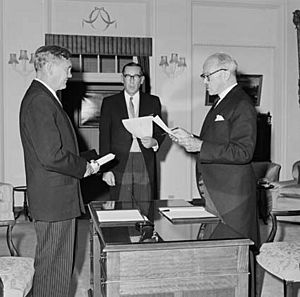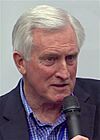Liberal Party of Australia facts for kids
Quick facts for kids
Liberal Party of Australia
|
|
|---|---|
 |
|
| Abbreviation |
|
| Leader | Sussan Ley |
| Deputy Leader | Ted O'Brien |
| Senate Leader | Michaelia Cash |
| Deputy Senate Leader | Anne Ruston |
| President | John Olsen |
| Founder | Robert Menzies |
| Founded | 13 October 1944 |
| Preceded by | United Australia |
| Headquarters | R. G. Menzies House, Barton, Australian Capital Territory |
| Think tank | Menzies Research Centre |
| Student wing | Liberal Students' Federation |
| Youth wing | Young Liberals |
| Women's wing | Federal Women's Committee |
| Overseas wing | Australian Liberals Abroad |
| Membership (2020) | |
| Ideology |
|
| Political position | Centre-right to right-wing |
| National affiliation | Liberal–National Coalition |
| Regional affiliation | Asia Pacific Democracy Union |
| International affiliation | International Democracy Union |
| Factions | Centrists Moderates Centre Right National Right |
| Colours | Blue |
| Governing body | Federal Council |
| Party branches |
|
| House of Representatives |
28 / 150
|
| Senate |
23 / 76
|
| State and territorial governments |
3 / 8
|
| State and territorial lower house members |
165 / 465
|
| State upper house members |
41 / 156
|
The Liberal Party of Australia (often called LP) is a major political party in Australia. It is known as a centre-right party. It is one of the two main parties in Australian politics, the other being the Australian Labor Party (ALP). The Liberal Party started in 1944. It took over from an older party called the United Australia Party.
The Liberal Party has been very successful in elections throughout Australia's history. Currently, it is the main opposition party at the national level. However, it is in government in the Northern Territory, Queensland, and Tasmania.
The Liberal Party works closely with the National Party. Together, they form a group called the Coalition. The National Party usually focuses on issues important to country areas. The Coalition was in charge of Australia from 2013 to 2022. During this time, they formed the Abbott (2013–2015), Turnbull (2015–2018), and Morrison (2018–2022) governments.
After the 2025 federal election, the Coalition was briefly suspended. However, the two parties formed a shadow ministry again on May 28, 2025. Sussan Ley is the current leader of the Liberal Party. She is also the Leader of the Opposition. Ley became leader in May 2025. She is the first woman to lead the Liberal Party. Two former leaders, Sir Robert Menzies and John Howard, were Australia's two longest-serving Prime Ministers.
The Liberal Party has a federal structure. This means it has separate groups in all six states and the Australian Capital Territory (ACT). The Country Liberal Party (CLP) in the Northern Territory is linked to the Liberal Party. The CLP and the Liberal National Party (LNP) in Queensland were formed when the local Liberal and National parties joined together.
The party's ideas are often called liberal or conservative. They usually support economic liberalism (free markets) and social conservatism (traditional values).
Contents
- How the Party Started
- The Menzies Era (1949–1966)
- The Holt Government (1966–1967)
- The Gorton Government (1968–1971)
- The McMahon Government (1971–1972)
- The Fraser Years (1975–1983)
- In Opposition (1983–1996)
- The Howard Government (1996–2007)
- In Opposition (2007–2013)
- Abbott, Turnbull, and Morrison Governments (2013–2022)
- Federal Opposition (2022–Present)
- State and Territory Governments
- Party Ideas and Beliefs
- Party Groups (Factions)
- How the Party is Organized
- Election Results in the House of Representatives
- See also
How the Party Started
Early Beginnings
The Liberal Party's roots go back to earlier groups that were against the Labor Party. The Commonwealth Liberal Party was formed in 1909. This happened when two parties, the Free Trade Party and the Protectionist Party, joined together. This was done by Alfred Deakin, who was Australia's second prime minister. They wanted to respond to the growing power of the Labor Party.
Later, the Commonwealth Liberal Party joined with some Labor members who disagreed with their party. They formed the Nationalist Party of Australia in 1917. This party then joined with other Labor members to create the United Australia Party (UAP) in 1931.
The UAP was a new conservative group formed in 1931. Its leader was Joseph Lyons, who had left the Labor Party. Lyons and other Labor members did not agree with some of Labor's ideas for dealing with the Great Depression. This attracted support from many Australian conservatives. The UAP won a big election victory in 1931. The Lyons government won three elections in a row. They focused on reducing debt and balancing the budget to help Australia recover from the Depression.
When Lyons died in 1939, Robert Menzies became Prime Minister. This was just before World War II started. Menzies was Prime Minister from 1939 to 1941. He resigned because his government did not have enough support in Parliament. The UAP then fell apart after losing badly in the 1943 election.
Forming the Liberal Party
From 1942, Robert Menzies gave radio talks called "The Forgotten People." In these talks, he spoke about the middle class. He called them the "backbone of Australia." He felt that political parties had "taken them for granted."
Menzies invited conservative parties and other groups who were against the Labor Party to a meeting. They met in Canberra on October 13, 1944, and again in Albury, New South Wales, in December 1944. Menzies shared his idea for a new political movement. He said they needed a "true revival of liberal thought." This thought would work for social justice, security, national power, and individual development. He said it would not be through "socialism."
The new party was officially announced in Sydney Town Hall on August 31, 1945. It was named Liberal to honor the old Commonwealth Liberal Party. The new party was mostly made up of members from the old UAP. A strong women's group, the Australian Women's National League, also joined. A youth group Menzies had started, the Young Nationalists, also became part of the new party. This group became the Young Liberals. By September 1945, the party had over 90,000 members. Many of them had never been part of a political party before.
The Menzies Era (1949–1966)

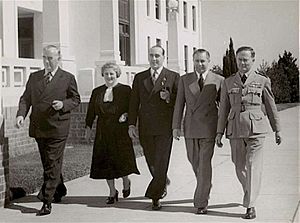
After losing the 1946 election, Menzies led the Liberals to victory in the 1949 election. The party stayed in power for a record 23 years. This is the longest time any party has continuously governed at the national level. Australia had strong economic growth during this time. Menzies kept his promises from the 1949 election. He ended rationing of butter, tea, and petrol. He also gave money to families for their first-born children.
Menzies was against Labor's plans to take over Australia's banks. After winning in 1949, he called for another election in April 1951. This happened after the Labor-controlled Senate rejected his banking laws. The Liberal-Country Coalition won and gained control of the Senate. They won again in 1954. A split in the Labor Party in 1955 helped the Liberals win again in December 1955. The Coalition won elections again in 1958, 1961, and 1963. Menzies left Parliament on January 26, 1966.
Menzies was strongly against Communism. He sent troops to the Korean War. He also tried to ban the Communist Party of Australia, but this failed in a referendum. The Labor Party split over concerns about Communist influence in unions. This led to the creation of the Democratic Labor Party. This new party often supported the Liberal and Country parties.
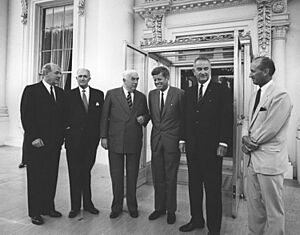
In 1951, during the Cold War, Menzies spoke about the possibility of a third world war. His government signed the ANZUS Treaty in 1951. This was Australia's first military alliance outside the British Commonwealth. It was with New Zealand and the United States. The treaty said that an attack on one country in the Pacific would be seen as a threat to all. In 1954, Menzies' government signed the South East Asia Collective Defence Treaty (SEATO). This was like NATO for Southeast Asia.
Menzies continued the immigration program that had started earlier. He also took important steps to end the White Australia Policy. In the early 1950s, Percy Spender helped create the Colombo Plan. This plan gave economic help to developing nations in Australia's region. Many future Asian leaders studied in Australia through this plan. In 1958, the government changed immigration laws. They replaced a difficult language test with a system based on skills and economic needs. In 1962, Menzies' law gave all Indigenous Australians the right to vote in federal elections. In 1949, the Liberals appointed Dame Enid Lyons as the first woman to serve in an Australian Cabinet.
Menzies retired in 1966. He had served as Prime Minister for 20 years in two separate periods. His second period of 17 years is the longest continuous time for a Prime Minister.
The Holt Government (1966–1967)
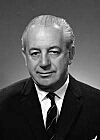
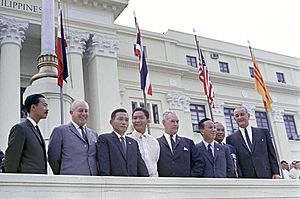
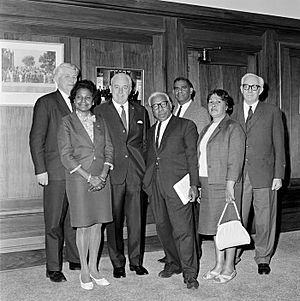
Harold Holt became Prime Minister after Robert Menzies retired in 1966. The Holt government won a large victory in the 1966 election. Holt remained Prime Minister until December 19, 1967. He disappeared while swimming in rough surf and was presumed dead. His body was never found.
Holt's government continued many of Menzies' policies. Senator Annabelle Rankin became Australia's first female minister in Holt's first government.
Holt increased Australia's involvement in the Vietnam War. This led to some public opposition. His government also changed Australia's money to decimal currency. Holt worked to strengthen ties with the United States. He hosted the first visit to Australia by an American president, Lyndon B. Johnson. Holt's government introduced the Migration Act 1966. This law effectively ended the White Australia Policy. It allowed more non-European migrants, including refugees from the Vietnam War.
Holt also called the important 1967 Referendum. This referendum moved responsibility for Aboriginal Affairs to the national Parliament. It also removed a part of the Australian Constitution that excluded Indigenous Australians from the census. The referendum was strongly supported by Australians, with over 90% voting "Yes." After the referendum, Holt created an Office of Aboriginal Affairs.
The Gorton Government (1968–1971)
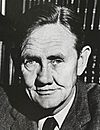
The Liberals chose John Gorton to replace Holt. Gorton was a former World War II pilot. He said he was "Australian to the bootheels." His personal style was sometimes seen as too casual by some conservatives.
The Gorton government increased funding for the arts. It set up the Australian Council for the Arts, the Australian Film Development Corporation, and a film and television training school. Gorton's government passed laws for equal pay for men and women. It also increased pensions, allowances, and education scholarships. It provided free health care for 250,000 poor Australians. Gorton's government kept Australia in the Vietnam War but stopped sending new troops at the end of 1970.
After the success of the 1967 Referendum, Gorton created the role of Minister for Aboriginal Affairs. Bill Wentworth was the first minister in this role. Gorton believed that government policy should help Aboriginal people become "self-supporting." The government started the Aboriginal Study Grants Scheme (ABSTUDY) in 1969. This helped Aboriginal and Torres Strait Islander people get better education.
Gorton kept good relations with the United States and Britain. But he also worked to build stronger ties with Asia. The Gorton government lost some voter support in the 1969 election. Some state Liberal leaders thought his policies gave too much power to the national government. Other Liberals did not like his personal behavior. In 1971, Defence Minister Malcolm Fraser resigned. He said Gorton was "not fit to hold the great office of Prime Minister." The Liberal Party voted on Gorton's leadership, and the vote was tied. Gorton decided this was not enough support, so he resigned.
The McMahon Government (1971–1972)
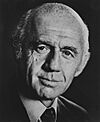
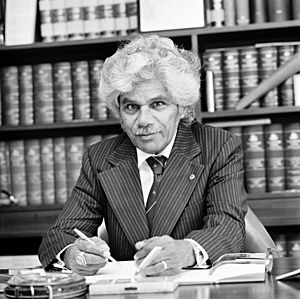
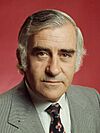
Foreign Affairs Minister William McMahon became Prime Minister after Gorton. Gorton briefly served as McMahon's deputy and Defence Minister. However, McMahon forced Gorton to resign in August 1971 due to "disloyalty." Treasurer Billy Snedden became the new deputy leader.
The economy was getting weaker as the post-war boom ended. McMahon pulled Australia's remaining troops out of Vietnam. He criticized Opposition leader Gough Whitlam for visiting China in July 1971. But soon after, US President Richard Nixon announced his own planned visit to China.
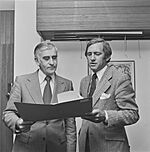
During McMahon's time, Neville Bonner joined the Senate. He became the first Indigenous Australian in the Australian Parliament. Bonner was chosen by the Liberal Party to fill a Senate vacancy in 1971. He was re-elected in 1972 and served as a Liberal Senator for 12 years. He worked on Indigenous and social welfare issues. He was an independent Senator and often voted against his party.
The McMahon government ended when Gough Whitlam led the Australian Labor Party to victory in the 1972 election. This ended the Labor Party's 23 years in opposition.
The Fraser Years (1975–1983)
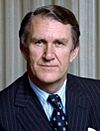
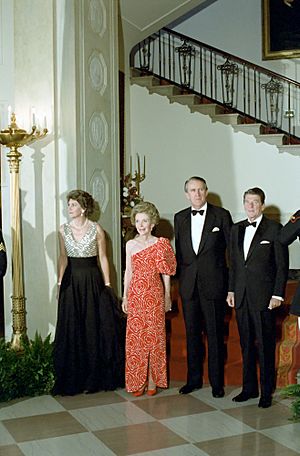
After the 1974–75 Loans Affair, the Malcolm Fraser-led Liberal-Country Party Coalition argued that the Whitlam government was not managing the country well. They delayed passing the government's money bills in the Senate. They wanted the government to call a new election. Whitlam refused. This led to a major political crisis in 1975. The crisis ended when the Whitlam government was controversially dismissed by the Governor-General, Sir John Kerr, on November 11, 1975. Fraser was then made caretaker prime minister until an election could be held. Fraser won the 1975 election by a large margin.
Fraser kept some of the social changes made by Whitlam. He also tried to control government spending. His government included the first Aboriginal federal politician, Neville Bonner. In 1976, Parliament passed the Aboriginal Land Rights Act 1976. This law gave "inalienable" ownership of some traditional lands to Aboriginal people in the Northern Territory. The Fraser government also started the multicultural broadcaster SBS. It accepted Vietnamese refugees. It was against minority white rule in South Africa and Rhodesia. It also opposed the Soviet Union's expansion.
The Liberals under Fraser won big majorities in the 1977 and 1980 elections. However, they did not make big economic changes. By 1983, the Australian economy was struggling with a recession and a severe drought. The Liberal Party lost to the Bob Hawke-led Australian Labor Party in the 1983 election.
In Opposition (1983–1996)
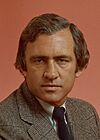
After losing power, the Liberals went through a period of disagreement. Former Treasurer John Howard and former foreign minister Andrew Peacock competed for leadership. Australia's economy faced a recession in the early 1990s. Unemployment reached 11.4% in 1992.
Under Dr John Hewson, the opposition released a big policy document called Fightback! in 1991. This plan included a goods and services tax (GST). It also proposed changes to Medicare and industrial relations. It suggested cutting personal income tax and government spending. It also wanted to sell many government-owned businesses. The 15 percent GST was the main part of the plan.
During 1992, Labor Prime Minister Paul Keating strongly opposed the Fightback package, especially the GST. He said it would hurt working-class people. Hewson then decided to remove food from the proposed GST. This led to confusion about what food would be taxed. Hewson had trouble explaining this to voters. This was shown in the famous birthday cake interview. Many people think this interview was a turning point in the election. Keating won the 1993 election, giving Labor a record fifth term.
The Howard Government (1996–2007)
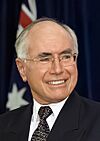
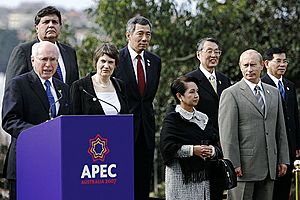
Labor's Paul Keating lost the 1996 Election to the Liberals' John Howard. The Liberals had been in opposition for exactly 13 years. John Howard became Prime Minister on March 11, 1996. With Howard as prime minister, Peter Costello as treasurer, and Alexander Downer as foreign minister, the Howard government stayed in power until they lost to Kevin Rudd in 2007.
Howard generally presented the Liberals as conservative on social policy. He focused on reducing debt and keeping ties with the Commonwealth and the American Alliance. However, during his time, trade with Asia grew a lot. Also, non-European immigration increased. His government signed a free trade agreement with the United States in 2004. Howard's time as Prime Minister also included the September 11 attacks in the United States. The Howard government used the ANZUS treaty to respond to the attacks. They supported America's military actions in Afghanistan and Iraq.
Howard supported traditional Australian things like the monarchy in Australia, ANZAC Day, and the design of the Australian flag. But like Keating, he privatized public services. He also introduced a broad consumption tax (the GST). Howard held a meeting in 1998 to discuss if Australia should become a republic. He then called a referendum in 1999. Voters rejected the idea of Australia becoming a republic. Howard did not support the republic. He suggested recognizing Aboriginal and Torres Islander peoples in the Constitution. But this idea was also voted down in the referendum.
In the 2004 federal elections, the party gained more seats in the lower house. With its coalition partners, it became the first government in 20 years to have a majority in the Senate. This control of both houses allowed them to pass laws without needing to negotiate with other parties. An example was the industrial relations law called WorkChoices. This law aimed to reduce rules in Australian workplaces.
The 2007 federal election saw the Howard government defeated. The Liberal Party was then in opposition at both state and federal levels across Australia.
In Opposition (2007–2013)
After the 2007 federal election, Dr Brendan Nelson was chosen as leader by the Liberal Party members in Parliament. In September 2008, Nelson lost the leadership to Malcolm Turnbull. In December 2009, Turnbull lost the leadership to Tony Abbott by a very close vote. Abbott led the party into the 2010 federal election. The Liberal Party gained more votes in this election. It resulted in the first hung parliament (where no party has a clear majority) since 1940.
In March 2011, the New South Wales Liberal-National Coalition, led by Barry O'Farrell, won government. This was a huge victory. In Queensland, the Liberal and National parties joined in 2008 to form the Liberal National Party of Queensland (LNP). In March 2012, the LNP won government in a historic landslide, led by Campbell Newman.
In March 2013, the Western Australian Liberal-National government won re-election. Tony Abbott then led the party to government in the 2013 Australian federal election. The 2013 federal election was the most recent time the Liberal Party and the Coalition saw an increase in their main vote in the House of Representatives.
Abbott, Turnbull, and Morrison Governments (2013–2022)
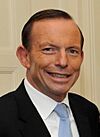
- Abbott Government (2013–2015)
The Abbott government aimed to reduce the national budget deficit. It signed free trade agreements with China, Japan, and South Korea. It removed the previous government's mining tax and carbon tax. It also started a Royal Commission to investigate trade unions.
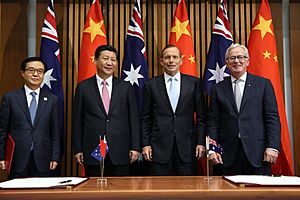
Abbott had promised to stop people smuggling. During his time, unauthorized boats arriving by sea stopped. In foreign policy, Australia continued its military involvement in the Middle East. In 2015, the Abbott government agreed to resettle 12,000 more refugees from that region. Abbott and Australia's first female Foreign Minister Julie Bishop challenged Russia at the United Nations. This was about the shooting down of Malaysian Flight MH17 in Ukraine. The government started the New Colombo Plan to encourage students to study in the Indo-Pacific region. At home, Abbott supported recognizing Indigenous Australians in the Australian Constitution. He also promised a public vote on same-sex marriage.
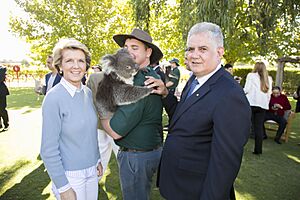
Treasurer Joe Hockey presented two budgets. The first focused on cutting spending but faced strong opposition. The second budget aimed to help small businesses. The Liberal Party faced some internal problems and early leadership challenges. This was due to the budget's reception and media criticism. Dissenters gathered around Abbott's rival, Malcolm Turnbull.
Abbott became one of Australia's shortest-serving Prime Ministers. Turnbull challenged him and won a leadership vote in September 2015. Turnbull said that poor poll results and economic leadership were reasons for his challenge.
- Turnbull Government (2015–2018)
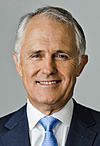
Turnbull appointed Scott Morrison as Treasurer. The Turnbull government continued many of Abbott's plans. It held a public vote that approved legal recognition of same-sex marriage. It also continued campaigns against domestic violence. It funded the National Disability Insurance Scheme. It signed the free trade deal with China and reformed Senate voting.
In April 2016, the Senate refused to pass a government bill. This gave Turnbull a reason to call a double dissolution election. An election was held on July 2, 2016. The government was re-elected, but its majority in the House of Representatives was reduced to just one seat. In 2017, it announced the construction of the Snowy 2.0 Pumped Storage Power Station.
Turnbull's removal of Abbott had divided the Liberal Party. Tensions continued within the parliamentary party. The government reached the point of 30 consecutive poor poll results in April 2018. This was the same benchmark Turnbull had used to challenge Abbott. Losses in by-elections in July 2018 further weakened Turnbull's authority. On August 21, 2018, Turnbull announced a leadership challenge. He narrowly won a party room vote against Home Affairs Minister Peter Dutton. But leadership tension continued. The party voted for a second leadership ballot on August 24. Turnbull chose not to stand. In that vote, Treasurer Scott Morrison was seen as a compromise candidate. He defeated both Dutton and Foreign Minister Julie Bishop to become leader of the Liberal Party. Morrison was elected as Turnbull's successor.
- Morrison Government (2018–2022)
In the first Morrison Ministry, Josh Frydenberg became Treasurer. Marise Payne became Foreign Minister. After losing the leadership, Turnbull left Parliament. This meant the Coalition became a minority government after a by-election. Morrison then restored the Coalition to a majority government in the 2019 Election.
Frydenberg and Payne stayed in their roles in the Second Morrison Ministry. This ministry was notable because it included Ken Wyatt as Minister for Indigenous Australians. He was the first Aboriginal Australian to be in the Federal Cabinet. It also had seven women members, the most in Australian history.
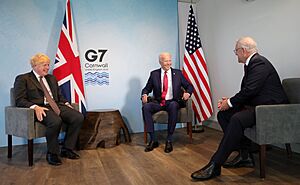
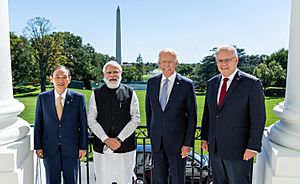
In economic affairs, Treasurer Frydenberg predicted a small budget surplus in 2019. However, the COVID-19 pandemic led to a big increase in government spending. Australia had a brief recession by September 2020. Managing the pandemic became a main focus for the Morrison government. It put in place strict border controls. It also created a National Cabinet to coordinate responses with state and territory governments. It started a program to support businesses and workers. Two years into the pandemic, Australia had one of the lowest death rates and highest vaccination rates in the world. By March 2022, Australia's unemployment rate was 4%. This was projected to drop to 3.75%, its lowest in 50 years.
In trade and international affairs, the Morrison government signed free trade agreements with Indonesia, the United Kingdom, and India. In the Indo-Pacific region, Morrison started the Pacific Step-Up initiative. This aimed to increase engagement with Pacific Island nations. He also brought back the Quadrilateral Security Dialogue with Japan, India, and the United States. He signed the AUKUS security pact with the United Kingdom and the United States. This aimed to increase defense cooperation. During this time, relations with China became worse. Australia called for an independent inquiry into the origins of COVID-19. China responded with trade sanctions. After the Russian invasion of Ukraine in 2022, Morrison sent Australian military, diplomatic, and humanitarian aid to Ukraine.
The Morrison government was defeated in the 2022 election. After this, Peter Dutton was chosen to replace Morrison as party leader. After leaving office, Morrison faced criticism. He revealed that he had secretly held several ministerial positions while serving as prime minister. This led to Parliament passing a motion against him.
Federal Opposition (2022–Present)

In 2023, the Liberal/National coalition government in New South Wales, led by Premier Dominic Perrottet, was defeated by the Labor Party. This resulted in the first Labor government in the state in 12 years.
In 2024, the party won government in Tasmania, Queensland, and the Northern Territory. At the start of 2025, polls showed the Peter Dutton-led Coalition was favored to win the federal election. However, their lead disappeared as the year went on. This was influenced by their domestic campaign and chaotic "centre-right" politics overseas, as the second Trump Administration began in the United States.
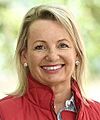
The Liberal Party lost the 2025 election. Dutton also lost his seat in Brisbane. After this election, Dutton resigned as party leader. He was replaced by Sussan Ley. Ley became the first woman to lead the Liberal Party and the first female Leader of the Opposition. She is part of the Moderate faction.
In May 2025, the federal National party briefly ended its coalition agreement with the Liberal Party. This meant the two parties operated separately for the first time since the 1980s. The Liberal Party became the only opposition party. However, the coalition was reformed on May 28, 2025. The two parties agreed on several joint policies and announced a shadow ministry.
When she was elected leader, Sussan Ley became the first woman to lead any Opposition at a federal level in Australian history. In her first speech to the National Press Club of Australia as leader in June 2025, Ley said:
Aspiration is the foundation of the Australian promise: that if you work hard, play by the rules, do your best for your kids and contribute to your community, you will be able to build a better life for yourself and your family. That promise feels distant for many Australians today... As we seek to regain trust with all voters across our great country, the task before me – and my team – is to lead a Liberal Party that respects modern Australia, reflects modern Australia and represents modern Australia.
—Sussan Ley, June 2025
State and Territory Governments
Since the Liberal Party started, it has been strong in most states for long periods. The exception is Queensland, where the National Party usually had more seats. However, in Queensland, the two parties joined to form the Liberal National Party of Queensland in 2008.
- South Australia
The Liberal and Country League (LCL) was a Liberal-linked party. Its leader, Tom Playford, was Premier from 1933 to 1965. The LCL changed its name to Liberal in 1974. Steele Hall of the LCL was Premier from 1968 to 1970. He started to fix an unfair electoral system.
Liberal David Tonkin became premier in 1979 for one term. He lost office in 1982. The Liberals returned to power in 1993. They were led by Premiers Dean Brown, John Olsen, and Rob Kerin for two terms. They lost in 2002. They were in opposition for 16 years. Then, Steven Marshall led the party to victory in the 2018 election. Marshall was removed from office after just one term in 2022.
- Western Australia
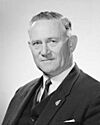
Sir Ross McLarty was the first Liberal Premier of Western Australia. He won elections for the new party in 1947 and 1950. Sir David Brand was a very important Liberal Premier. He won four elections from 1959 to 1968. He finally lost to Labor in 1971.
Brand continued as Liberal leader in Opposition until 1973. Sir Charles Court then became leader. He won three elections in 1974, 1977, and 1980. Ray O'Connor succeeded him and won in 1982. He was then defeated by Labor's Brian Burke in 1983. Labor stayed in office until 1990. This period had some corruption scandals. The Liberals returned to power in WA for much of the 1990s under Richard Court. He won in 1993 and 1996. He lost to Labor in 2001.
The Liberals returned to power in the 2008 election. Labor was defeated after seven years. Colin Barnett became premier with support from the WA Nationals and three independent politicians. Barnett then won a large majority for the Liberal-National Coalition in the 2013 election. The Liberals won enough seats to govern on their own.
Barnett's Liberals lost badly in the 2017 election to Labor's Mark McGowan. McGowan won strongly again in 2021. This was after he became popular for managing the COVID-19 pandemic. The Liberals won only two seats in the Lower House. The Nationals became the largest opposition party. In 2025, the Liberals under Libby Mettam won seven seats in the Lower House. The Nationals won six. This allowed the Liberals to become the main Opposition Party again.
- Victoria
The Liberals were in power in Victoria from 1955 to 1982. Jeff Kennett led the party back to government in 1992. He remained premier until 1999. Ted Baillieu led the Liberal-National Coalition to government in Victoria in 2010. This ended ten years of Labor rule. He retired from politics before the 2014 election. Denis Napthine briefly became Liberal Premier. His one-term government was defeated by Dan Andrews. Andrews went on to win three elections for Labor.
- New South Wales

In New South Wales, the Liberal Party has not been in office as much as Labor. Only three leaders have led the party from opposition to government in that state. They are Sir Robert Askin (1965–1975), Nick Greiner (1988–1992), and Barry O'Farrell (2011). O'Farrell led the party out of 16 years in opposition with a huge victory in 2011. The Coalition won a second big victory in March 2015. This was led by Premier Mike Baird. He promised many transport and infrastructure projects.
After Mike Baird resigned in 2017, Gladys Berejiklian was elected party leader. She became the first female Liberal Premier. She led the Coalition to victory in the 2019 New South Wales state election. Berejiklian and her successor Dominic Perrottet continued the party's big infrastructure plans. The Coalition lost to Labor in the 2023 election.
- Tasmania
Angus Bethune was elected as the first Liberal Premier of Tasmania in 1969. But Labor returned in 1972 and governed until Robin Gray led the Liberals back to power in 1982. He won again in 1986. Ray Groom won again for the Liberals in 1992 and 1996. Then Labor was in power for 16 years from 1998. Will Hodgman won office for the Liberals in 2014. This started a long period of Liberal government. Hodgman won the 2018 election. His successors Peter Gutwein won in 2021, and Jeremy Rockliff in 2024.
- Queensland
For many years, the Liberals were the smaller partner in the Coalition in Queensland. The Nationals were stronger there. In 2008, the Liberal and National Parties joined to form the Liberal National Party of Queensland (LNP). Campbell Newman led the LNP to a huge victory in 2012. This ended 13 years of Labor rule. However, Labor returned in the 2015 Queensland state election and stayed in power for almost ten years. Then David Crisafulli won in October 2024.
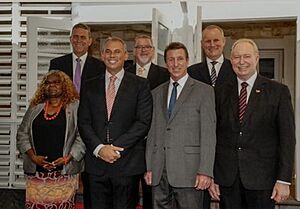
- The Territories
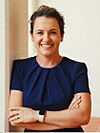
The Country Liberal Party governed the Northern Territory from 1978 to 2001. After Labor ruled the Northern Territory from 2001, the Liberal-linked Country Liberal Party returned to office in 2012. This was under Terry Mills. In 2013, Adam Giles was elected party leader. He was the first Aboriginal Australian to lead an Australian State or Territory. Giles lost the 2016 Territory Election. This led to ten years of Labor rule. Lia Finocchiaro brought the Country Liberals back into office in the 2024 election.
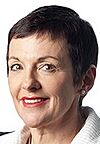
Labor won government in the Australian Capital Territory's first election in 1989. However, the Liberal Trevor Kaine became the first male Chief Minister of the ACT in December 1989. He lost the position in 1991.
In 1995, Liberal Kate Carnell won the 1995 election. She became the first woman to lead any party from Opposition to Government in Australian history. She served as Chief Minister of the ACT from 1995 to 1998. Liberal Gary Humphries succeeded her and kept the party in office until 2000.
The Liberals have been out of office in the Australian Capital Territory since 2000. In 2016, the Canberra Liberals lost their fifth election in a row. Elizabeth Lee, who is Korean-Australian, became the leader of the ACT Liberals in 2020. She was the first Australian of Asian background to lead a major party. Lee led the party to defeat in the 2024 ACT election.
The Liberal Party does not officially run in most local government elections. However, many members do run for local office as independent candidates. An exception is the Brisbane City Council. Here, both Sallyanne Atkinson and Campbell Newman have been elected Lord Mayor of Brisbane.
Party Ideas and Beliefs
Since it started, the Liberal Party has had many different ideas among its members. It mainly sees itself as a party that is against Labor and socialism. It supports individual freedom and private businesses.
The party's founder, Robert Menzies, believed that Australia's middle class would be its main supporters. He called them "The forgotten people" when the party was formed.
Towards the end of his time as Prime Minister, Menzies spoke about the "Liberal Creed" in 1964. He said:
As the etymology of our name "Liberal" indicates, we have stood for freedom... We took the name 'Liberal' because we were determined to be a progressive party, willing to make experiments, in no sense reactionary but believing in the individual, his right and his enterprise, and rejecting the socialist panacea. We have realised that men and women are not just ciphers in a calculation, but are individual human beings whose individual welfare and development must be the main concern of government... We have learned that the right answer is to set the individual free, to aim at equality of opportunity, to protect the individual against oppression, to create a society in which rights and duties are recognised and made effective.
After the Howard government was elected, John Howard spoke about his view of the "Liberal Tradition" in 1996. He said:
Menzies knew the importance for Australian Liberalism to draw upon both the classical liberal as well as the conservative political traditions. He believed in a liberal political tradition that encompassed both Edmund Burke and John Stuart Mill—a tradition which I have described in contemporary terms as the broad church of Australian Liberalism.
Until the 2022 election, the Liberals were largely the party of the middle class. However, voting patterns are not as clear now. In the 1970s, a left-leaning middle class emerged that no longer voted Liberal. During John Howard's time as prime minister, the Liberals gained more support from socially conservative working-class voters. Until 2022, the Liberal Party's main support came from the upper-middle classes. In country areas, they either compete with or work with the Nationals.
Menzies strongly supported the constitutional monarchy. He supported the monarchy in Australia and ties to the Commonwealth of Nations. Today, the party is divided on whether Australia should become a republic. Some, like former leader Peter Dutton, support the monarchy. Others, like his successor Sussan Ley, support Australia becoming a republic. The Menzies government formally made an alliance with the United States in 1951. The party has remained a strong supporter of this defense treaty.
At home, Menzies oversaw an economy with many rules. Public services were owned by the government. Business activity was highly regulated. Liberal leaders from Menzies to Malcolm Fraser generally kept Australia's high tariff levels. At that time, the Country Party (now the National Party) had a lot of influence over the government's economic policies. It was not until the late 1970s and 1980s that the party was influenced by the "New Right." This group supported fewer government rules, selling public services, reducing government programs, and cutting taxes.
Socially, the party believes in liberty and free enterprise. But it also includes both "small-l liberalism" and social conservatism. Historically, Liberal governments have made important social changes. These include opening Australia to multiethnic immigration under Menzies and Harold Holt. Holt's 1967 Referendum on Aboriginal Rights was another example. John Gorton supported cinema and the arts. Malcolm Fraser passed the Aboriginal Land Rights Act 1976.
The Liberal Party is a member of the International Democracy Union and the Asia Pacific Democrat Union.
Party Groups (Factions)
After the 2025 federal election, there are two main groups, or factions, in the federal Liberal Party in Parliament. These are the Moderates and the National Right. These groups can change, and are often based on people's personalities. Some individuals might belong to more than one group or not belong to any.
During the Morrison government years, there were three main groups: a moderate wing, a centre-right wing, and a right wing. These were led by Simon Birmingham, Scott Morrison, and Peter Dutton respectively. The Centre-Right was the largest group. The 2022 Australian federal election changed these groups a lot. The National Right became the largest group. The Centre-Right became the smallest. The Moderates' numbers dropped. A new Centrist group appeared. In 2025, Ley, from the moderate group, was elected leader of the party.
How the Party is Organized
| Position | Leader | House | Electorate | Faction |
|---|---|---|---|---|
| Party office | ||||
| President | John Olsen | N/A | ||
| Treasurer | Charlie Taylor | N/A | ||
| Director | Andrew Hirst | N/A | ||
| Parliament | ||||
| Leader | Sussan Ley | House of Representatives | Farrer, NSW | Moderate |
| Deputy Leader | Ted O'Brien | House of Representatives | Fairfax, Qld | Moderate |
| Manager of Opposition Business in the House | Alex Hawke | House of Representatives | Mitchell, NSW | Centre Right |
| Manager of Opposition Business in the Senate | Jonathon Duniam | Senate | Tasmania | National Right |
| Senate Leader | Michaelia Cash | Senate | Western Australia | National Right |
| Deputy Senate Leader | Anne Ruston | Senate | South Australia | Moderate |
The Liberal Party is organized with strong state divisions. This shows the party's original belief in a federal system of government. Robert Menzies purposely created a weak national party and strong state groups. The party's policies are mostly made by the politicians in Parliament. However, Liberal party members do have some say in policy.
The smallest group in the Liberal Party is the branch. This is made up of party members in a local area. For each electorate (voting area), there is a conference. This group helps with campaigning and talks to the local politician or candidate. Australia has three levels of government. So, each branch sends representatives to local, state, and federal conferences.
All the branches in an Australian state form a Division. The main group for the Division is a State Council. There is also one Federal Council that represents the entire Liberal Party organization in Australia.
Party Leaders in Parliament
State and Territory Divisions
| Division | Leader | Last election | Status | Federal representatives | |||||||||
|---|---|---|---|---|---|---|---|---|---|---|---|---|---|
| Lower House | Upper House | MPs | Senators | ||||||||||
| Year | Votes (%) | Seats | TPP (%) | Votes (%) | Seats | ||||||||
| Queensland | David Crisafulli | 2024 | 41.5 |
52 / 93
|
53.8 | N/A | Majority government |
21 / 30
|
5 / 12
|
||||
| Northern Territory | Lia Finocchiaro | 2024 | 49.0 |
17 / 25
|
57.1 | N/A | Majority government |
0 / 2
|
1 / 2
|
||||
| New South Wales | Mark Speakman | 2023 | 26.78 |
25 / 93
|
45.73 | 29.78 |
10 / 42
|
Liberal–National Coalition opposition |
9 / 47
|
4 / 12
|
|||
| Victoria | Brad Battin | 2022 | 29.76 |
19 / 88
|
45.00 | 29.44 |
14 / 40
|
Liberal–National Coalition opposition |
6 / 39
|
3 / 12
|
|||
| South Australia | Vincent Tarzia | 2022 | 35.67 |
16 / 47
|
45.41 | 34.38 |
8 / 22
|
Opposition |
3 / 10
|
6 / 12
|
|||
| Tasmania | Jeremy Rockliff | 2024 | 36.67 |
14 / 35
|
N/A | N/A |
4 / 15
|
Minority government |
2 / 5
|
4 / 12
|
|||
| Canberra | Leanne Castley | 2024 | 33.5 |
9 / 25
|
N/A | N/A | Opposition |
0 / 3
|
0 / 2
|
||||
| Victoria | Brad Battin | 2022 | 29.76 |
19 / 88
|
45.00 | 29.44 |
14 / 40
|
Liberal–National Coalition opposition |
6 / 39
|
3 / 12
|
|||
| Western Australia | Basil Zempilas | 2025 | 28.0 |
7 / 59
|
42.9 | 27.27 |
10 / 36
|
Liberal–National opposition alliance |
5 / 15
|
5 / 12
|
|||
Federal Presidents
Party Groups and Networks
The Liberal Party has several groups and networks. The main ones are:
- The Australian Liberal Student's Federation (for students)
- The Federal Women's Committee (for women)
- The Young Liberals (for young people)
Other groups include Australian Liberals Abroad (for members living overseas) and a Norfolk Island group.
Election Results in the House of Representatives
| Election | Leader | Votes | % | Seats | +/– | Position | Status |
|---|---|---|---|---|---|---|---|
| 1946 | Robert Menzies | 1,431,682 | 32.95 |
15 / 74
|
Opposition | ||
| 1949 | 1,813,794 | 39.39 |
55 / 121
|
Coalition | |||
| 1951 | 1,854,799 | 40.62 |
52 / 121
|
Coalition | |||
| 1954 | 1,745,808 | 38.31 |
47 / 121
|
Coalition | |||
| 1955 | 1,746,485 | 39.73 |
57 / 122
|
Coalition | |||
| 1958 | 1,859,180 | 37.23 |
58 / 122
|
Coalition | |||
| 1961 | 1,761,738 | 33.58 |
45 / 122
|
Coalition | |||
| 1963 | 2,030,823 | 37.09 |
52 / 122
|
Coalition | |||
| 1966 | Harold Holt | 2,291,964 | 40.14 |
61 / 124
|
Coalition | ||
| 1969 | John Gorton | 2,125,987 | 34.77 |
46 / 125
|
Coalition | ||
| 1972 | William McMahon | 2,115,085 | 32.04 |
38 / 125
|
Opposition | ||
| 1974 | Billy Snedden | 2,582,968 | 34.95 |
40 / 127
|
Opposition | ||
| 1975 | Malcolm Fraser | 3,232,159 | 41.80 |
68 / 127
|
Coalition | ||
| 1977 | 3,017,896 | 38.09 |
67 / 124
|
Coalition | |||
| 1980 | 3,108,512 | 37.43 |
54 / 125
|
Coalition | |||
| 1983 | 2,983,986 | 34.36 |
33 / 125
|
Opposition | |||
| 1984 | Andrew Peacock | 2,951,556 | 34.06 |
45 / 148
|
Opposition | ||
| 1987 | John Howard | 3,175,262 | 34.41 |
43 / 148
|
Opposition | ||
| 1990 | Andrew Peacock | 3,468,570 | 35.04 |
55 / 148
|
Opposition | ||
| 1993 | John Hewson | 3,923,786 | 37.10 |
49 / 147
|
Opposition | ||
| 1996 | John Howard | 4,210,689 | 38.69 |
75 / 148
|
Coalition | ||
| 1998 | 3,764,707 | 33.89 |
64 / 148
|
Coalition | |||
| 2001 | 4,244,072 | 37.40 |
68 / 150
|
Coalition | |||
| 2004 | 4,741,458 | 40.47 |
74 / 150
|
Coalition | |||
| 2007 | 4,546,600 | 36.60 |
55 / 150
|
Opposition | |||
| 2010 | Tony Abbott | 3,777,383 | 30.46 |
60 / 150
|
Opposition | ||
| 2013 | 4,134,865 | 32.02 |
74 / 150
|
Coalition | |||
| 2016 | Malcolm Turnbull | 3,882,905 | 28.67 |
60 / 150
|
Coalition | ||
| 2019 | Scott Morrison | 3,989,435 | 27.97 |
61 / 151
|
Coalition | ||
| 2022 | 3,502,713 | 23.89 |
42 / 151
|
Opposition | |||
| 2025 | Peter Dutton | 3,205,216 | 20.69 |
28 / 150
|
Opposition |
See also
 In Spanish: Partido Liberal de Australia para niños
In Spanish: Partido Liberal de Australia para niños
- Country Liberal Party (Northern Territory)
- Liberal National Party (Queensland)
- Liberal Party of Australia (New South Wales Division)
- Liberal Party of Australia (South Australian Division)
- Liberal Party of Australia (Tasmanian Division)
- Liberal Party of Australia (Victorian Division)
- List of political parties in Australia
- Turnbull Government (2015–2018)
- Abbott Government (2013–2015)
- Liberalism in Australia
- Moderates
- Young Liberal Movement of Australia


